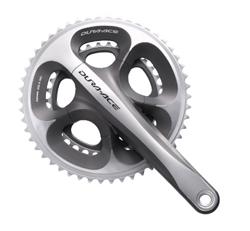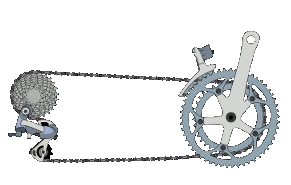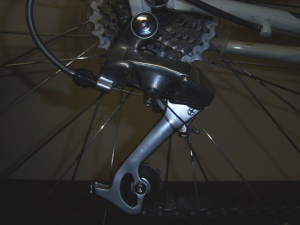Do You Need a Compact Crankset

What is a compact crankset?
Compact cranksets are used on many road bikes. In the past few years bicycle and componet manufactures have come out with many new options. With the advent of 1x11 mountain bike gearing and cassettes with 48 teeth, the possibilities are nearly endless. Some are very pricy. Matching derailleurs with chainrings and shifters can be a challenge too. For now will look at some of the simpler options. If you have a touring bike or a crossbike you will typically have a triple chain ring on your crankset. Perhaps you want to try a compact crankset. While the compact crankset may be lighter this is not the primary concern in deciding to switch. Road bikes usually have a large chain ring with 52 or 53 teeth and a small chain ring with 39 teeth or sometimes 42 teeth. The Shimano Dura-Ace compact crankset that I am eyeing for my bike has chain rings of 50 and 34 teeth. This means a change in the effective gearing for all ten cogs. Before we talk about Gear Inches, just look at the basic reduction in ratios. Another factor to consider if you have owned your bicycle for a while, you will probably also need a new bottom bracket.
 It really comes down to how far you travel with one complete rotation of the cranks. The idea of the gear inch goes back to the high wheelers
with the cranks fixed to the front wheel. To go faster you had to have a larger front wheel. This also made it more difficult to climb hills. After
riding in Southern Illinois on grades of near 11 percent I am thinking that a lower ratio may be a benefit, if I tour on my road bike. Image courtesy Keithonearth Wikimedia.
It really comes down to how far you travel with one complete rotation of the cranks. The idea of the gear inch goes back to the high wheelers
with the cranks fixed to the front wheel. To go faster you had to have a larger front wheel. This also made it more difficult to climb hills. After
riding in Southern Illinois on grades of near 11 percent I am thinking that a lower ratio may be a benefit, if I tour on my road bike. Image courtesy Keithonearth Wikimedia.
Moving from 53 teeth on the big chain ring to just 50 is a reduction to 94.3% of the original size. On the small chain ring the change is to 87.2% of the original size. This will result in a lower low gear and a lower high gear. Since I have never been able to push high RPM on the 53 tooth ring when using the smallest rear cog, I do not expect any real change in my top speed. The benefit for me is a lower low gear for climbing. The highest point in Illinois is only 1227 feet, so it really isn't a great need at home. Where it can make a difference is in climbing or riding on grades for an extended period of time. Near the Garden of the gods in the Shawnee National Forest is the second highest point in Illinois and plenty of roller coaster hills. This gave me a change to see how well I might do on a trip with more grades. That is why I am at least looking at the possibility of the compact crankset for my transcontinental bike ride. This will be especially true if you are touring with a load.
If you opt for the 34 small chain ring and your largest cog on your cassette is 24 teeth you will rotate the wheel 1.4 times for each revolution of your crank. On the standard crankset you would rotate the wheel 1.6 times for each revolution of the crank. What will this mean in distance traveled? A 700cX25 tire has circumference of 82.12 inches. Doing the multiplication we find 116.34 inches traveled using the compact crankset and 133.44 inches using the standard crankset. If you take this one more step dividing the distance traveled using the compact crankset by the distance using the standard crankset you will find the former distance is 87% of the latter distance. You could also think of this as increasing your mechanical advantage. I prefer spinning around 100RPM. I typically cannot do that on a grade. On my ride on the hills of Southern Illinois I was down to about 50 rpm on the cranks up the last hill with a 39x26 ratio. Using the compact crankset should help me to maintain a more comfortable spin.
Alternatives to compact cranksets
Use a Larger Cog
Instead of using the compact crankset, you can choose to keep your standard crankset and use a larger cog set on your cassette. You will need to find out the largest cog (sprocket) that your rear derailleur will handle. This is known as the derailleur capacity. If you change to a larger rear cog like a 27 tooth and use it with a 39 tooth chain ring you will now have a ratio of 1.44. Compare this ratio to the 34/24 in the earlier example with the compact crankset. The ratio is slight more than the 1.4 due to rounding. The real difference in the two ratios is slightly less than two percent. These ratios are so close you could continue using the standard crankset, avoiding the cost of the new compact crankset. This option is only available to you, if your current derailleur as enough capacity for the larger cog. Road bikes generally use short cage derailleurs with capacities smaller than the long cage derailleurs used for mountain bikes.
Use a Mountain Bike CassetteOne more possibility is switching to a mountain bike cassette. This will most likely require using a mountain bike derailleur and probably a longer chain. If you pair a 32 tooth cog with the standard 39 tooth chain ring, you have a ratio of 1.2 or a reduction of about 16%. While you will not have the granny gears available on a mountain bike or a touring bicycle with triple chain rings, You will have a low ratio comparable to the compact crankset.
Recently, cogset with up to 42 teeth have been made available. Now you can buy a 1x10 setup for a mountain bike. That is one cog in the front and a ten speed cog in the rear. I will look at the possible ratios and write about the possiblities for this setup on a touring bicyle.
One thing to consider, if you look at compact cranksets: make sure it will be compatible with your chain and derailleur. It may not work to mix Shimano, SRAM and Campagnolo. Do a little research before you buy.
UpdateAfter pulling a B.O.B trailer coast-to-coast on Adventure Cycling's Northern Tier Route, I am sure that I need a triple crank for loaded touring. I did meet one fellow riding with a compact crank on a road bike pulling a trailer. It is possible if you have the strength. I have installed a compact crank on one of my road bicycles.
The Compact Crank on the RoadWith more than a thousand miles on a compact crank, here is what I have found. As fall rolls around, I am often using the smaller cogs on my ten speed cassette. This means I am using the big chain ring (50 teeth) more frequently. When I am climbing with the small chain ring the 21 tooth cog is often selected. This is almost the same as the standard setup using 39/24. If I get into steeper hills, there are two more lower gears. I still need to try the compact crank on some long steep grades. The decission to use the compact crankset comes down to the available ratios, the terrain where you ride and your fitness level. One thing I know for sure, I will continue with a triple crankset on my touring bicycle.


 United States
United States